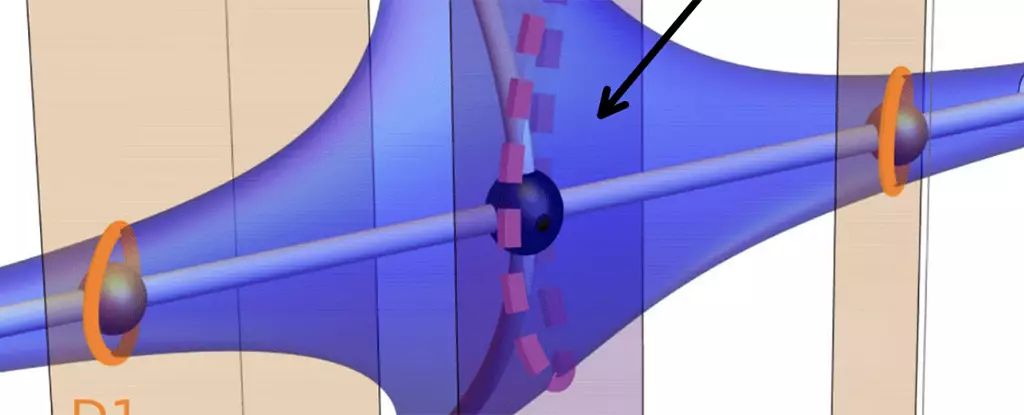In a remarkable development within the realm of condensed matter physics, scientists have recently confirmed the existence of a theoretical quasiparticle known as the semi-Dirac fermion. This exciting finding comes 16 years after its initial prediction, pushing the boundaries of our understanding of particle behavior in unexpected ways. Unlike traditional particles that possess a consistent mass regardless of their directional movement, semi-Dirac fermions exhibit a unique characteristic: they possess an effective mass solely when traversing through specific pathways within a material.
Mass, a fundamental property in physics, can be perplexing. It traditionally indicates a particle’s resistance to acceleration and is intimately linked to energy. However, not all mass is uniform. For instance, we can think of rest mass—the mass a particle retains when stationary—as distinct from the dynamic mass that arises during motion. This new discovery adds yet another layer to this concept, highlighting how the effective mass of these quasiparticles shifts depending on the direction of movement. In essence, the semi-Dirac fermion behaves like a chameleon, adapting its response to applied forces based on its travel path.
The groundbreaking research was conducted in a ZrSiS semi-metal crystal subjected to extreme low temperatures of -452 degrees Fahrenheit (-269 degrees Celsius). These extreme conditions are pivotal for the emergence of rare quasiparticles such as the semi-Dirac fermion. This research is critical, as it opens new avenues for understanding more complex particle interactions, particularly within the framework of quantum physics and technological advancements.
The Unanticipated Discovery
An international team of researchers, led by physicist Yinming Shao from Pennsylvania State University, made this serendipitous discovery while investigating the properties of ZrSiS. Initially, the research group did not set out to find semi-Dirac fermions; rather, they were conducting experiments that unexpectedly revealed “signatures” of this unusual quasiparticle. As Shao remarked, “We weren’t even looking for a semi-Dirac fermion when we started working with this material, but we were seeing signatures we didn’t understand.”
This revelation underscores the unpredictability and excitement inherent in scientific research, where chance discoveries often lead to significant advancements. The semi-Dirac fermion is characterized by its bizarre ability to transition between behaving as a massless particle in one direction and displaying effective mass in another. This dual behavior is indicative of a fundamental principle in physics that still requires extensive investigation.
To observe the semi-Dirac fermions, the researchers employed an advanced technique known as magneto-optical spectroscopy. This method involves studying materials’ responses to infrared light as they are influenced by remarkably strong magnetic fields—about 900,000 times stronger than the Earth’s magnetic field, as generated by the National High Magnetic Field Laboratory in Florida. It is under these extraordinary conditions that the unparalleled interactions at the quantum level can be closely examined.
By combining this sophisticated analysis with numerical modeling, researchers could accurately analyze the quasiparticle activity, leading to the revelation of how these particles lack mass in one directional pathway while maintaining substantial effective mass in another. This duality offers a refreshing lens through which to understand particle dynamics.
To aid in comprehending this complex phenomenon, Shao presents a relatable analogy. He likens the movement of semi-Dirac fermions to a tiny train navigating a network of tracks. In the scenario, this train can travel at light speed along certain paths but experiences resistance—and thus gains mass—upon reaching intersections where it must switch to a perpendicular track. This model highlights the important variable of directionality in particle movement and the resulting consequences on their mass properties.
The Road Ahead: Implications and Challenges
Despite the thrill of this discovery, many questions remain unanswered. Researchers are keen to explore further the properties and potential applications of the semi-Dirac fermion, including practical uses in electronic sensors and advancements in quantum computing. There is also a pressing challenge to investigate how to isolate single layers of ZrSiS crystals, as current conditions rely on manipulating the multi-layered structure.
The identification of semi-Dirac fermions represents a landmark moment in particle physics, serving as a reminder of the vast frontiers still existing beyond our current comprehension. Each answer and advancement opens the door to new questions, propelling the scientific community forward in its quest to understand the universe’s intricacies. As Shao aptly puts it, “The most thrilling part of this experiment is that the data cannot be fully explained yet,” emphasizing the myriad possibilities awaiting discovery in the ever-expanding field of physics.


Leave a Reply